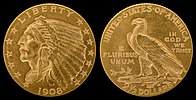Our website is made possible by displaying online advertisements to our visitors.
Please consider supporting us by disabling your ad blocker.
Wikipedia:Today's featured article/February 12, 2018
The Indian Head gold pieces were two coin series struck by the United States Mint: a two-and-a-half dollar piece, or quarter eagle (1908–1915, 1925–1929), and a five-dollar coin, or half eagle (1908–1916, 1929). The only US coins with recessed (engraved) designs ever to enter circulation, they were the last of a long series of coins in those denominations. President Theodore Roosevelt vigorously advocated new coin designs, and had the Mint engage his friend, the sculptor Augustus Saint-Gaudens, to design coins that could be changed without congressional authorization. The sculptor completed an eagle ($10 piece) and double eagle before his death in 1907. Roosevelt convinced Mint Director Frank Leach to reproduce the eagle's design on both of the smaller coins, but recessed below the background. The job fell to Boston sculptor Bela Lyon Pratt, and after some difficulty, the Mint was able to strike the coins, though Pratt was unhappy with modifications made by the Mint's engravers. The quarter eagle enjoyed popularity as a Christmas present, but neither coin circulated much. (Full article...)
Previous Page Next Page



